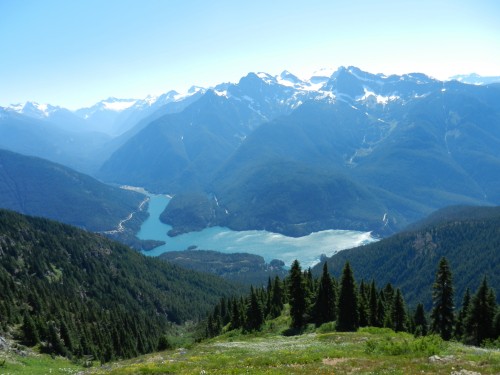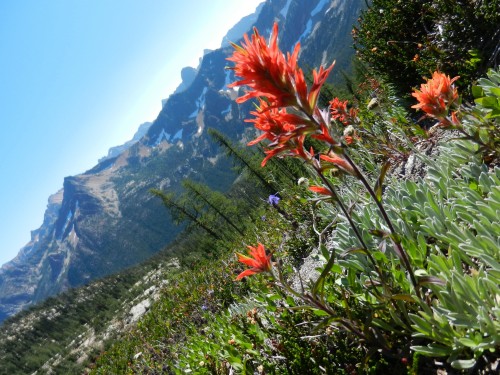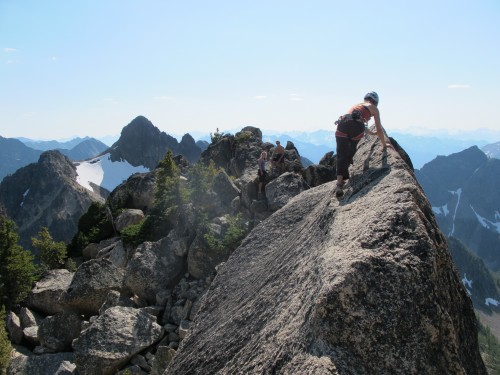Peaks in Place
 Lately, on these cool autumn mornings at the North Cascades Environmental Learning Center, I’ve taken to gazing south from my porch as the first, angled rays of sun illuminate the buttress of Pyramid Peak across Diablo Lake. Since our first torrential weather event passed through a few weeks ago, the steep walls of Pyramid have glistened with snow dustings in the early light, giving relief and texture to the bare, sculptured rock. I breathe deeply, savoring my gratitude for these moments to welcome the day.
Lately, on these cool autumn mornings at the North Cascades Environmental Learning Center, I’ve taken to gazing south from my porch as the first, angled rays of sun illuminate the buttress of Pyramid Peak across Diablo Lake. Since our first torrential weather event passed through a few weeks ago, the steep walls of Pyramid have glistened with snow dustings in the early light, giving relief and texture to the bare, sculptured rock. I breathe deeply, savoring my gratitude for these moments to welcome the day.
Sometimes I wonder at how lucky I am to be living in the presence of such rugged giants as Pyramid, Colonial and Sourdough peaks in the heart of the North Cascades. In my first month of being here as part of the M.Ed.Graduate Program, I have sought to learn the names and scale the slopes of these and other mountains in my new backyard as a way to understand, and become attentive to, the stories written on this landscape. Some peaks — Desolation, Logan, Hozomeen, the McMillan Spires — appear as glimpses on clear days if you stand in the right drainage, at the right angle and distance. I still shout and point when I see them, for their glaciated summits rise as silent, colossal forms into the sky.
There are other, equally impressive peaks to revel at and explore, ones more navigable by foot, rope, and a short drive along Highway 20. I have traversed the ridgeline of Cutthroat Peak on Washington Pass, surprised at the shifting abundance of alpine wildflowers as I moved from the East to West slopes of the mountain. Liberty Bell and Early Winters Spires rising prominently to the southeast of Cutthroat have offered climbs along their bases to blue lakes and opportunities to scale their jutting walls with rope and harness. At such elevations the immensity of the North Cascades stretches beyond my imagination, the peaks unfolding across the horizon too numerous to name and all the more beautiful because of it.
 View East from Cutthroat Ridge with Indian paintbrush and wholly pussytoes in the foreground. Photo by Kiira Heymann.
View East from Cutthroat Ridge with Indian paintbrush and wholly pussytoes in the foreground. Photo by Kiira Heymann.
The ruggedness of this landscape seems to ask of its inhabitants that we learn the names and stories that give context and meaning to its form. Its history runs seventeen miles deep and spans multiple ice ages, periods of volcanism and accretion, and untold patterns of weathering, growth, and decay. Yet, I sense part of the story of this place lies deeper still and is one not easily understood through rote scientific discussions. It is a story revealed only with great patience and guided by receptivity to the beauty of these mountainous slopes. Learning to hear it requires that we affirm our sense of wonder at life, for it asks that we celebrate the process every day of falling in love with, and greeting, the mysterious delights of the natural world found here in the North Cascades.
 Near the summit of South Early Winters Spire. Photo by Kai Girard.
Near the summit of South Early Winters Spire. Photo by Kai Girard.
As I continue to get my bearings in my new home by naming, exploring, and traversing some of the region’s drainages and peaks, I hope also to find pieces of this deeper story, and to cherish and hold in gratitude a growing understanding of this place.
Leading picture taken looking southeast from atop Sourdough Peak. Photo by Kiira Heymann.

